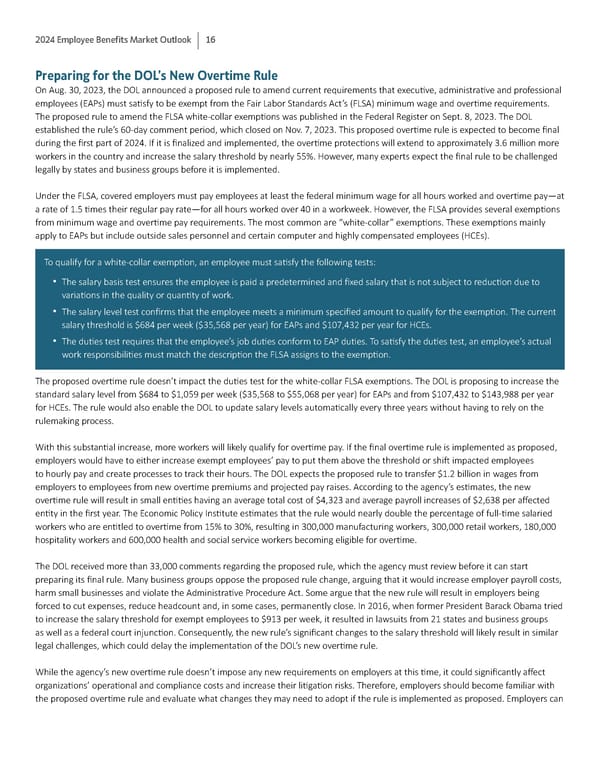2024 Employee Benefits Market Outlook 16 Preparing for the DOL’s New Overtime Rule On Aug. 30, 2023, the DOL announced a proposed rule to amend current requirements that execu琀椀ve, administra琀椀ve and professional employees (EAPs) must sa琀椀sfy to be exempt from the Fair Labor Standards Act’s (FLSA) minimum wage and over琀椀me requirements. The proposed rule to amend the FLSA white-collar exemp琀椀ons was published in the Federal Register on Sept. 8, 2023. The DOL established the rule’s 60-day comment period, which closed on Nov. 7, 2023. This proposed over琀椀me rule is expected to become 昀椀nal during the 昀椀rst part of 2024. If it is 昀椀nalized and implemented, the over琀椀me protec琀椀ons will extend to approximately 3.6 million more workers in the country and increase the salary threshold by nearly 55%. However, many experts expect the 昀椀nal rule to be challenged legally by states and business groups before it is implemented. Under the FLSA, covered employers must pay employees at least the federal minimum wage for all hours worked and over琀椀me pay—at a rate of 1.5 琀椀mes their regular pay rate—for all hours worked over 40 in a workweek. However, the FLSA provides several exemp琀椀ons from minimum wage and over琀椀me pay requirements. The most common are “white-collar” exemp琀椀ons. These exemp琀椀ons mainly apply to EAPs but include outside sales personnel and certain computer and highly compensated employees (HCEs). To qualify for a white-collar exemp琀椀on, an employee must sa琀椀sfy the following tests: • The salary basis test ensures the employee is paid a predetermined and 昀椀xed salary that is not subject to reduc琀椀on due to varia琀椀ons in the quality or quan琀椀ty of work. • The salary level test con昀椀rms that the employee meets a minimum speci昀椀ed amount to qualify for the exemp琀椀on. The current salary threshold is $684 per week ($35,568 per year) for EAPs and $107,432 per year for HCEs. • The du琀椀es test requires that the employee’s job du琀椀es conform to EAP du琀椀es. To sa琀椀sfy the du琀椀es test, an employee’s actual work responsibili琀椀es must match the descrip琀椀on the FLSA assigns to the exemp琀椀on. The proposed over琀椀me rule doesn’t impact the du琀椀es test for the white-collar FLSA exemp琀椀ons. The DOL is proposing to increase the standard salary level from $684 to $1,059 per week ($35,568 to $55,068 per year) for EAPs and from $107,432 to $143,988 per year for HCEs. The rule would also enable the DOL to update salary levels automa琀椀cally every three years without having to rely on the rulemaking process. With this substan琀椀al increase, more workers will likely qualify for over琀椀me pay. If the 昀椀nal over琀椀me rule is implemented as proposed, employers would have to either increase exempt employees’ pay to put them above the threshold or shi昀琀 impacted employees to hourly pay and create processes to track their hours. The DOL expects the proposed rule to transfer $1.2 billion in wages from employers to employees from new over琀椀me premiums and projected pay raises. According to the agency’s es琀椀mates, the new over琀椀me rule will result in small en琀椀琀椀es having an average total cost of $4,323 and average payroll increases of $2,638 per a昀昀ected en琀椀ty in the 昀椀rst year. The Economic Policy Ins琀椀tute es琀椀mates that the rule would nearly double the percentage of full-琀椀me salaried workers who are en琀椀tled to over琀椀me from 15% to 30%, resul琀椀ng in 300,000 manufacturing workers, 300,000 retail workers, 180,000 hospitality workers and 600,000 health and social service workers becoming eligible for over琀椀me. The DOL received more than 33,000 comments regarding the proposed rule, which the agency must review before it can start preparing its 昀椀nal rule. Many business groups oppose the proposed rule change, arguing that it would increase employer payroll costs, harm small businesses and violate the Administra琀椀ve Procedure Act. Some argue that the new rule will result in employers being forced to cut expenses, reduce headcount and, in some cases, permanently close. In 2016, when former President Barack Obama tried to increase the salary threshold for exempt employees to $913 per week, it resulted in lawsuits from 21 states and business groups as well as a federal court injunc琀椀on. Consequently, the new rule’s signi昀椀cant changes to the salary threshold will likely result in similar legal challenges, which could delay the implementa琀椀on of the DOL’s new over琀椀me rule. While the agency’s new over琀椀me rule doesn’t impose any new requirements on employers at this 琀椀me, it could signi昀椀cantly a昀昀ect organiza琀椀ons’ opera琀椀onal and compliance costs and increase their li琀椀ga琀椀on risks. Therefore, employers should become familiar with the proposed over琀椀me rule and evaluate what changes they may need to adopt if the rule is implemented as proposed. Employers can
 2024 Employee Benefits Market Outlook Page 15 Page 17
2024 Employee Benefits Market Outlook Page 15 Page 17